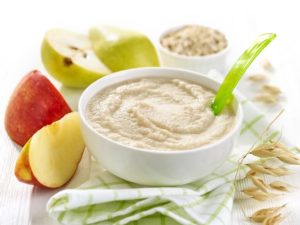Colostrum is the first milk that a baby takes in. It is already formed during pregnancy. Its ingredients are ideally suited to newborns. Colostrum builds up the baby’s intestinal flora.
It provides proteins that initiate the immune system, protecting the baby from pathogens. The yellow, viscous milk is only present in small quantities. It is just right for your baby.
It first has to get used to eating food. That’s why colostrum has a similar structure to amniotic fluid. Many proteins stimulate the metabolic cycle so that your baby excretes all excess substances from its body.
The article shows you what substances colostrum contains and how they work in the baby’s body. It also provides you with instructions on how to obtain and freeze colostrum even before birth.
Table of contents
Colostrum – what is it?
Colostrum has a different composition than breast milk, which is formed only after the milk has been expressed. Colostrum is the pre-milk. It is formed in your breasts from the middle of pregnancy.
You may notice that your breasts change during pregnancy. They become fuller and may become taut. The mammary glands change and the glandular tissue increases. The breasts are preparing to take care of your baby.
This includes the production of colostrum. This milk is waiting for the birth of the baby, so to speak. Even if you have a premature baby, colostrum is present.
When you put your baby to the breast after birth, colostrum helps to supply your baby with important nutrients. Its composition is different from that of mature breast milk, which is only present after the milk has been expressed.
After two to three, sometimes even up to seven days after birth, milk is expressed. The prerequisite for this is that you attach your baby or empty the breasts by hand or pump.
The breasts initially produce a transitional milk that is whiter and somewhat fattier. After about two weeks, the mature breast milk forms. This is white to bluish and rich in fat.
Colostrum: What you should know
Colostrum is a miracle of your body and a precious gift for your baby. It forms the ideal basis for feeding the baby. The amount of colostrum is exactly adapted to the needs of your baby.
Colostrum is yellow in color and thick in consistency. This is not the only reason why it is called liquid gold. Its composition is adapted to the sensitive stomach of the newborn. Until now, the baby has only consumed amniotic fluid.
It is not used to fat and sugar. Colostrum has a similar structure to amniotic fluid and therefore contains little sugar and fat, but a large amount of protein. After the introduction of milk, the baby gets more fat from the milk.
Colostrum regulates the heat balance, the blood sugar level and the fluid balance. The diverse ingredients promote the growth, development and immune system of your baby.
Colostrum contains these nutrients:
- Lots of protein
- Little fat and lactose (easily digestible)
- Immunoglobulins
- sIgA (secretory immunoglobulin A)
- Minerals
- Enzymes
- Vitamins
- Stem cells
In total, colostrum consists of about 200 substances. Whereby the breakdown and research of the exact mode of action of colostrum is not yet complete.
Colostrum develops the intestinal flora and protects against diseases
Your baby is well protected in the belly. It grows up germ-free. Although it already receives antibodies through your bloodstream, no germs penetrate from the outside. This changes with birth. Here the baby comes into contact with viruses and bacteria for the first time.
In a natural birth, these are vaginal germs; in a C-section, they may be hospital germs. Colostrum contains many proteins that are effective against germs.
These include sIgA and other immunoglobulins. Your baby gets them through the colostrum. These proteins provide the basis for a healthy intestinal flora and a good immune defense.
The substance sIgA is particularly concentrated in colostrum, accounting for up to 50 percent of the colostrum.
It collects the antibodies that you have in your body. All diseases, against which you have formed antibodies, you pass on to your baby. The protein sIgA determines 80 percent of the immune defense. Just a few drops of colostrum will protect your baby.
The milk passes through the esophagus into the stomach and then into the intestines. The immunoglobulins form a thin film on the mucous membranes of the mouth, esophagus, urinary tract and gastrointestinal tract. On the one hand, they build up a healthy environment there.
They also attract bacteria that support digestion. On the other hand, they protect the newborn from diseases and infections. If you breastfeed, you keep giving your child antibodies.
They spread throughout the baby’s body, building up an immune system that protects the baby from the first germs. This nest protection lasts up to twelve months. If you get sick during this time, your baby gets the antibodies through breast milk.
After six months, the nest protection slowly decreases. Regardless of whether you continue to breastfeed or not. From twelve months, your baby will gain experience in dealing with illnesses. You have given him a good basis for this through the colostrum (and breastfeeding).
You should bear this in mind
Colostrum stimulates the newborn’s digestion. This is important because the baby’s body in utero contains a high proportion of red blood cells for an optimal supply of oxygen.
These must be excreted, otherwise they can cause neonatal jaundice. If you feed your baby frequently or give him colostrum regularly, this will boost the entire metabolism.
Your baby gradually excretes everything it ingested in the womb. The liver breaks down the red blood cells, producing the byproduct bilirubin. If the liver is not fully developed, bilirubin accumulates in the body.
Your baby will have yellowish eyes and skin. In the hospital and midwives at home check whether everything is right with the metabolism of your favorite or whether there is a need for action.
Baby’s stools are black at first. After the milk has come in, it may turn green and finally liquid and yellow. The right diaper saves you nerves, time and laundry. Take some time for this and find out about different diapers in the test.
These vitamins are contained in breast milk
Sure, your baby doesn’t live on protein, sugar and fat alone. Vitamins are essential for survival. Especially vitamin A is important for babies, because they have only small reserves of this vitamin.
Here you have an overview of which vitamins are responsible for what:
Vitamin A
Vision, immune defense, healthy skin
Vitamin B
Nerves, metabolism, blood formation, cell division
Vitamin D
Strong bones and teeth
Vitamin K
Blood clotting
In addition to vitamins, it also contains many minerals and trace elements. Sodium and potassium regulate the baby’s fluid balance. People need iron for the formation of blood cells and for the immune system.
In the womb, babies store a reserve of iron in their liver during the last months of pregnancy. This lasts for up to six months. Babies utilize the iron contained in colostrum and mature breast milk particularly well.
Colostrum contains the trace elements copper, magnesium, iodine, selenium and zinc. They support the newborn in building the immune system, the rapid development of the brain, the heart and the bones.
If you eat a balanced diet during pregnancy and breastfeeding, your baby will get everything it needs. If you eat a vegetarian or vegan diet, you can support the increased nutritional needs with supplements.
What if the colostrum is not enough?
Many mothers are afraid in the first days after birth that the milk will not be enough. This worry is unfounded. A newborn’s stomach is small and not stretchy.
The baby can only take in small amounts of food, seven milliliters per meal on the first day. If you feed your baby regularly, the amount of milk will increase from 100 milliliters per day at the beginning to 500 milliliters on the fourth day.
The milk supply increases significantly. Nevertheless, the baby loses weight in the first three days after birth. Five to seven percent is normal.
The baby excretes everything it has absorbed in the abdomen.
The urine is yellow, the first stool black. It is called puerperal feces or meconium. If the baby loses more than seven percent of its weight, it should be checked whether everything is going well with breastfeeding.
Only if the baby loses ten percent of its birth weight can supplementary feeding be advisable.
The onset of milk
The composition of breast milk changes with the onset of milk. The onset of milk is heralded by a feeling of warmth and taut breasts. The breasts become harder, larger, plump and may hurt.
Cooling compresses can relieve the pressure. A midwife, lactation nurse or lactation consultant can help you deal with the onset of milk. Transition milk gives your baby more fluids and more calories.
Your baby’s bowel movements will change. Yellow stools are normal now. Your baby may also have green stools.
Due to the formula, yellow stools are very liquid with yellow chunks until the baby eats porridge.
It is not only the baby who needs attention. You should also take advantage of the postpartum checkup to check for big changes in your body.
You don’t want to or can’t breastfeed?
Even if you cannot or do not want to breastfeed, it is possible to give your baby colostrum. If you can breastfeed, feed your baby after birth.
After births using painkillers, the milk may not flow. Or you may not be able to breastfeed for other reasons. Nevertheless, you can feed your baby with colostrum.
Lay your baby naked on your bare chest or belly. Cuddle as often as you can, the close contact supports your baby and you. Your baby builds up a bond with you.
Your hormones adjust as a result of skin contact and allow milk production. You can express colostrum from your breast with your hand[/url]. Feed your baby with a syringe, spoon, or cup.
Start one hour after birth. A small amount is enough. Repeat the process every two to three hours. Use an electric pump for this later.
Colostrum kit
It is possible that you store colostrum before birth for personal or medical reasons. You will need 1 ml syringes, which you can buy in pharmacies or online. All materials must be sterile, your hands very clean and warm.
In a relaxed atmosphere, gently massage your breasts on all sides. This may be unusual, but it will stimulate the flow of milk. After several minutes of massage, gently stroke the outside of the breasts towards the nipple (this is called a “rub out”).
This should not hurt you. The success varies. Some women can collect only a few drops, others a larger amount. You label the syringes with small sticky notes with the following information:
- Your name
- Your date of birth
- Date and time of freezing
- If necessary: other family name of the child












